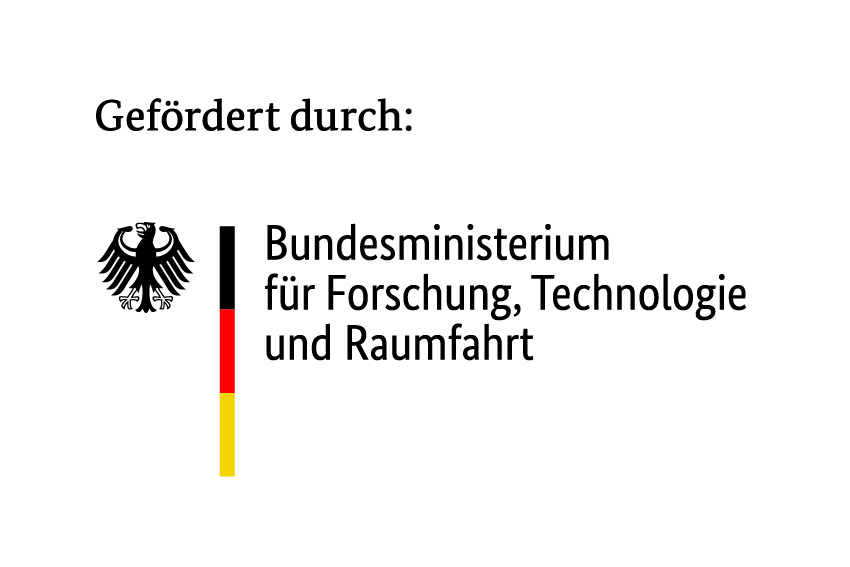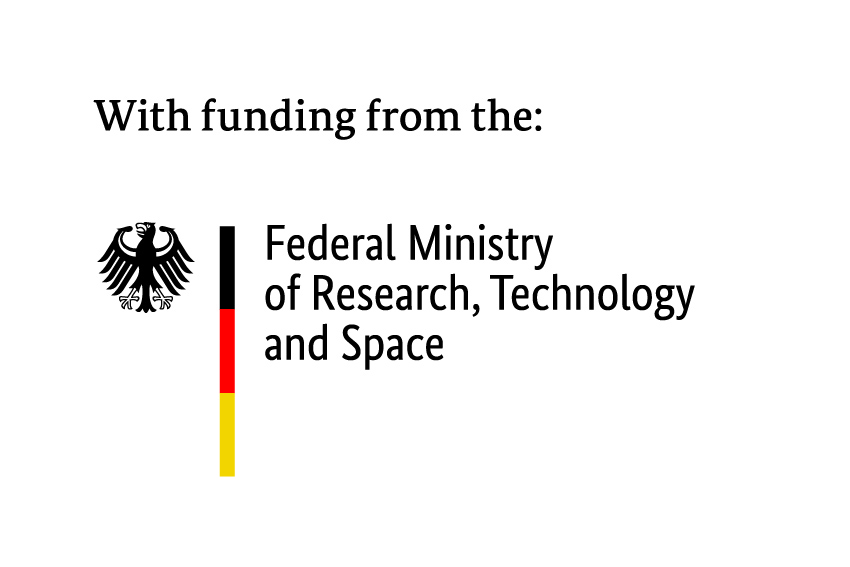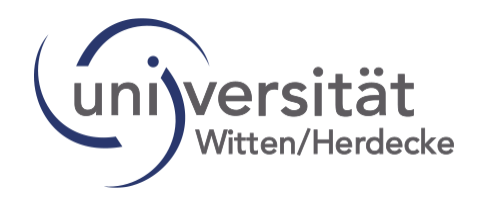Climate Change and Global Finance at the Crossroads: Political Challenges, Political-Economic Dynamics and Sustainable Transformation
SuFi
The collaborative project “Climate Change and Global Finance at the Crossroads” (SuFi) aims to develop an interdisciplinary analytical framework that collects data on the interplay of climate finance with civil society, financial and regulatory policy, making it processable and analyzable. The project aims to develop policy recommendations that create incentives for financial actors to become significantly more engaged in sustainable finance. The joint project consists of two subprojects.
Subproject 1: Private financial actors, government climate policy and sustainable finance
The first subproject focuses on financial market dynamics and the responsiveness of private financial actors regarding regulations, fiscal and monetary policy.

Subproject 2: Civil Society and Climate Finance
The second subproject focuses on civil society demands and campaigns and the interplay and reflexivity of all these areas among and with each other.

Publications from SuFi
SuFi I Channels of influence in sustainable finance: A framework for conceptualizing how private actors shape the green transition
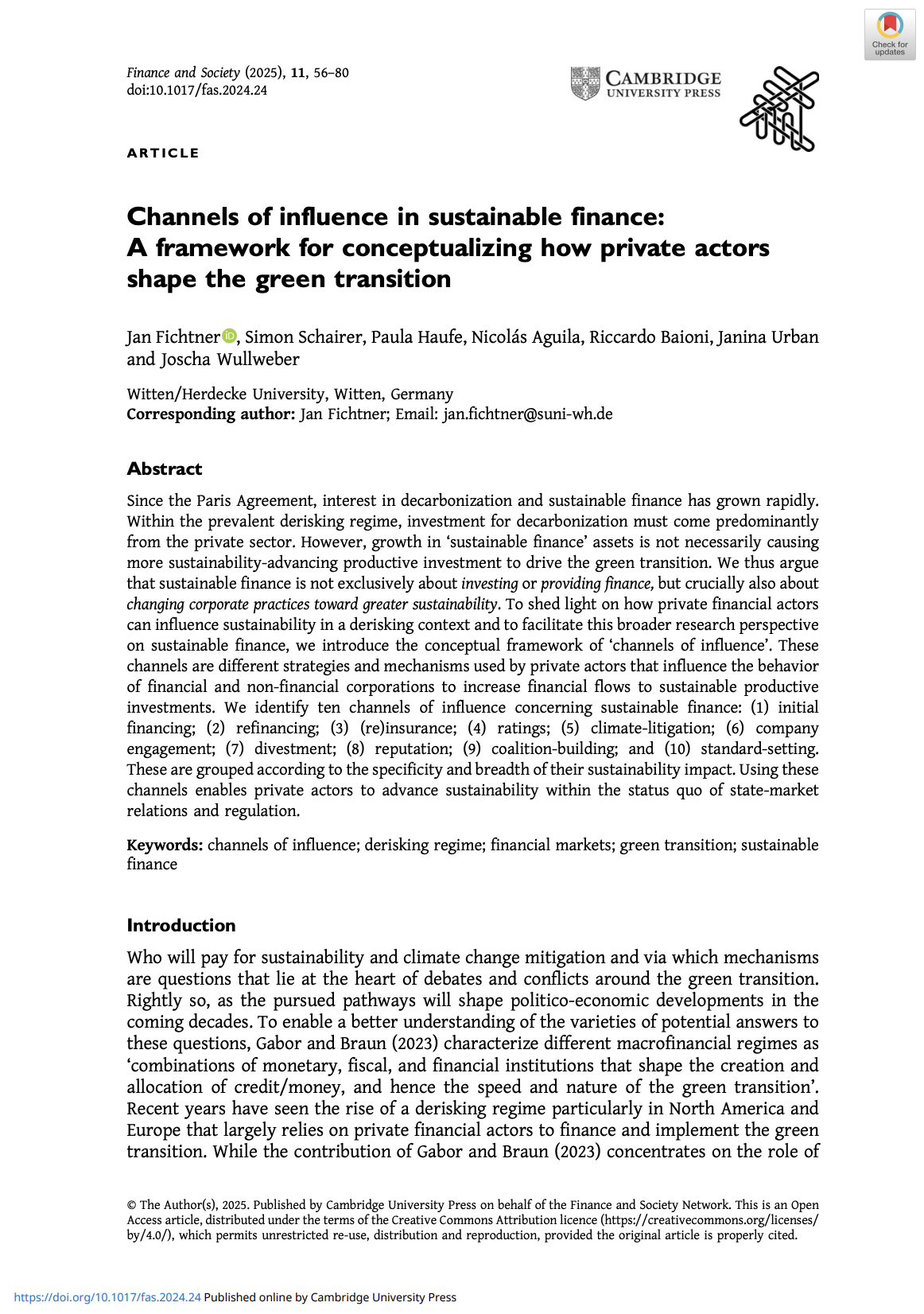
Channels of influence in sustainable finance: A framework for conceptualizing how private actors shape the green transition
Since the Paris Agreement, interest in decarbonization and sustainable finance has grown rapidly. Within the prevalent derisking regime, investment for decarbonization must come predominantly from the private sector. However, growth in ‘sustainable finance’ assets is not necessarily causing more sustainability-advancing productive investment to drive the green transition. We thus argue that sustainable finance is not exclusively about investing or providing finance, but crucially also about changing corporate practices toward greater sustainability. To shed light on how private financial actors can influence sustainability in a derisking context and to facilitate this broader research perspective on sustainable finance, we introduce the conceptual framework of ‘channels of influence’. These channels are different strategies and mechanisms used by private actors that influence the behavior of financial and non-financial corporations to increase financial flows to sustainable productive investments. We identify ten channels of influence concerning sustainable finance: (1) initial financing; (2) refinancing; (3) (re)insurance; (4) ratings; (5) climate-litigation; (6) company engagement; (7) divestment; (8) reputation; (9) coalition-building; and (10) standard-setting. These are grouped according to the specificity and breadth of their sustainability impact. Using these channels enables private actors to advance sustainability within the status quo of state-market relations and regulation.
- Veröffentlichungsdatum: 27. Januar 2025
- Autor:innen: Jan Fichtner, Simon Schairer, Paula Haufe, Nicolás Aguila, Riccardo Baioni, Janina Urban and Joscha Wullweber
- Publikationsart: Article
- Keywords: channels of influence; derisking regime; financial markets; green transition; sustainable finance
- Link zum PDF-Dokument
SuFi I Die grüne Transformation finanzieren: Bankfähigkeit erhöhen, aus klimaschädlichen Investitionen aussteigen, nicht bankfähige Aktivitäten finanzieren
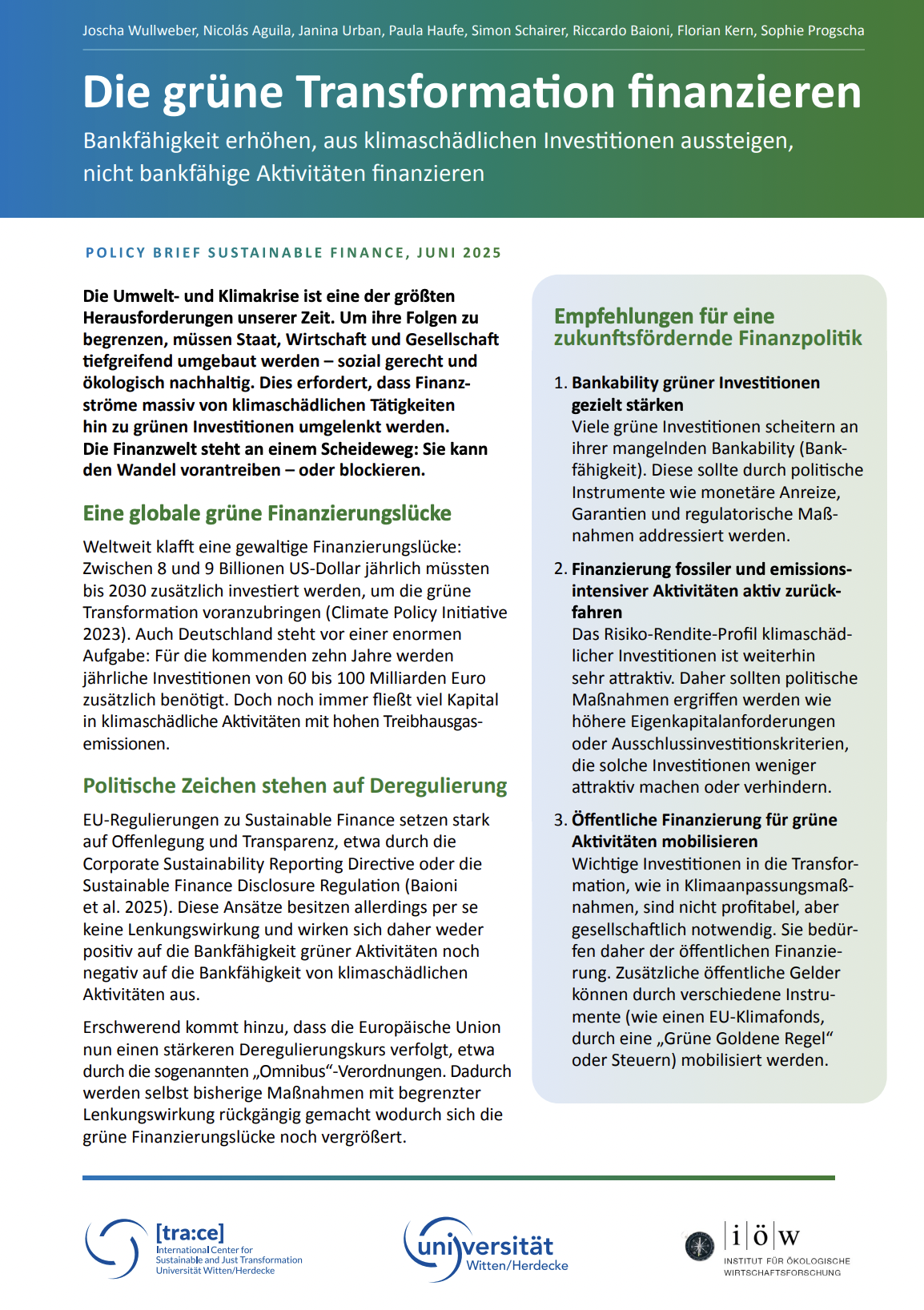
Die grüne Transformation finanzieren Bankfähigkeit erhöhen, aus klimaschädlichen Investitionen aussteigen, nicht bankfähige Aktivitäten finanzieren
Die Umwelt- und Klimakrise ist eine der größten Herausforderungen unserer Zeit. Um ihre Folgen zu begrenzen, müssen Staat, Wirtschaft und Gesellschaft tiefgreifend umgebaut werden – sozial gerecht und ökologisch nachhaltig. Dies erfordert, dass Finanzströme massiv von klimaschädlichen Tätigkeiten hin zu grünen Investitionen umgelenkt werden. Die Finanzwelt steht an einem Scheideweg: Sie kann den Wandel vorantreiben – oder blockieren.
- Veröffentlichungsdatum: Juni 2025
- Autor:innen: Joscha Wullweber, Nicolás Aguila, Janina Urban, Paula Haufe, Simon Schairer, Riccardo Baioni, Florian Kern, Sophie Progscha
- Publikationsart: Policy Brief
- Link zum PDF-Dokument
SuFi I Financing the green transition: Increasing bankability, phasing out carbon investments and funding 'never-bankable' activities
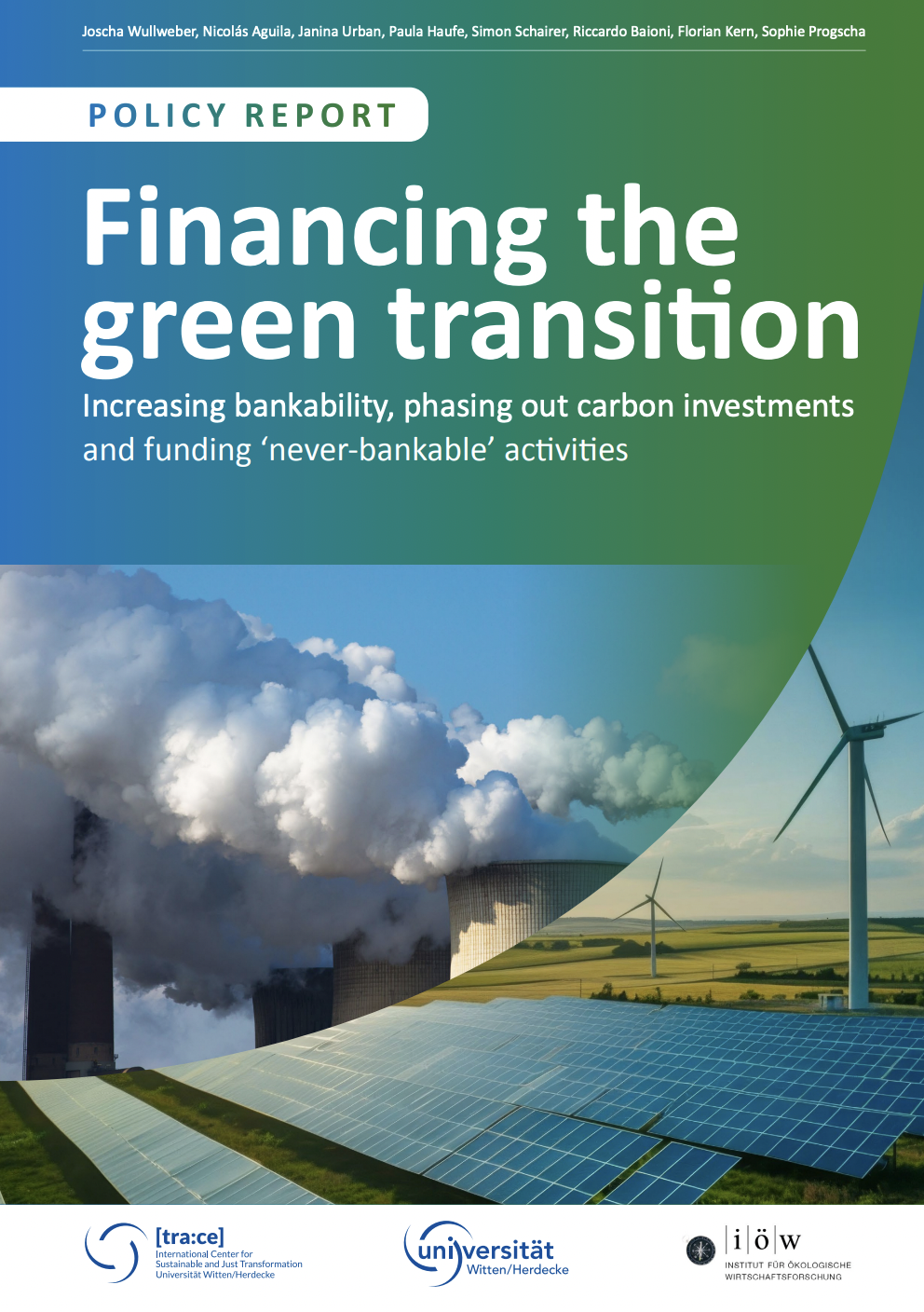
Financing the green transition: Increasing bankability, phasing out carbon investments and funding 'never-bankable' activities
Why does a large green financing gap persist despite intensified efforts in recent years to mobilize financial resources? What policy instruments and strategies could be used to steer financial flows from unsustainable to sustainable investments? Based on a mixed-methods approach, that combined document analysis of over 330 key documents and 88 semi-structured interviews, the policy report shows that the problem is not the lack of capital, but the lack of bankable green projects. Increases in green lending and investments by banks and other financial institutions remain negligible because green investments fail to meet the desired risk-return profiles of investors. In other words, many green firms and projects are considered as ‘non-bankable’. Based on our analysis, we propose a classification that considers two criteria: 1) Is the investment green or does it generate high GHG emissions? 2) Is it bankable, not yet bankable, or never bankable? This taxonomy forms the basis for the projects’ policy recommendations that can increase the bankability of not-yet bankable firms and projects, decrease the bankability of high-GHG emitting ones, and expand financing for never bankable activities
- Veröffentlichungsdatum: 26.06.2025
- Autor:innen: Joscha Wullweber, Nicolás Aguila, Janina Urban, Paula Haufe, Simon Schairer, Riccardo Baioni, Florian Kern, Sophie Progscha
- Publikationsart: Policy Report
- Keywords: Sustainable Finance, Green Transision, Financial Policies, Green Central Banking, Sustainable Transformation, Bankability, Decarbonisation, Green investment, Shadow carbon financing, Green Financing Gap
- Link zum PDF-Dokument
SuFi I Greener and cheaper: Green monetary policy in the era of inflation and high interest rates
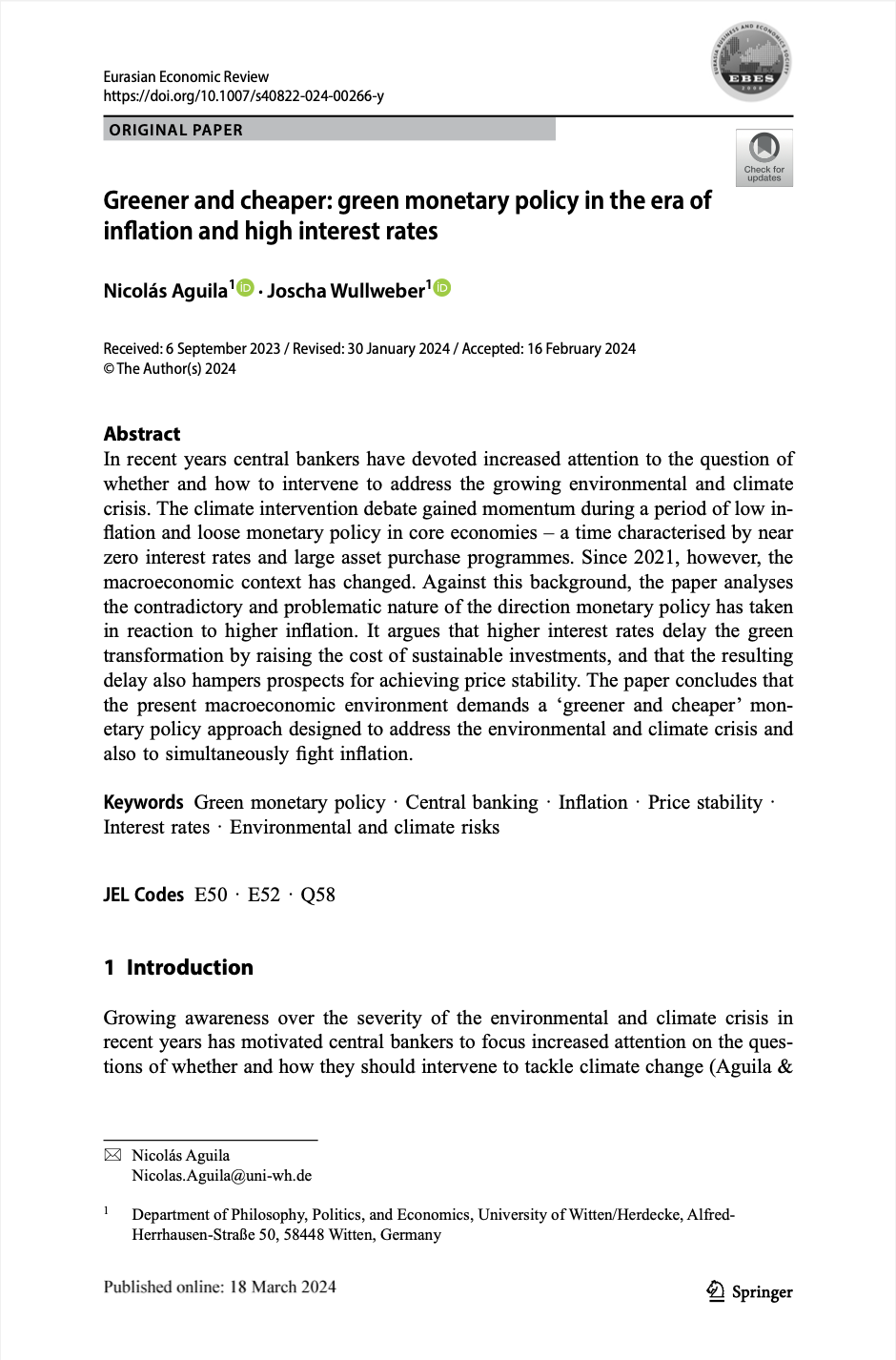
Greener and cheaper: Green monetary policy in the era of inflation and high interest rates
In recent years central bankers have devoted increased attention to the question of whether and how to intervene to address the growing environmental and climate crisis. The climate intervention debate gained momentum during a period of low inflation and loose monetary policy in core economies – a time characterised by near zero interest rates and large asset purchase programmes. Since 2021, however, the macroeconomic context has changed. Against this background, the paper analyses the contradictory and problematic nature of the direction monetary policy has taken in reaction to higher inflation. It argues that higher interest rates delay the green transformation by raising the cost of sustainable investments, and that the resulting delay also hampers prospects for achieving price stability. The paper concludes that the present macroeconomic environment demands a ‘greener and cheaper’ monetary policy approach designed to address the environmental and climate crisis and also to simultaneously fight inflation.
- Veröffentlichungsdatum: 18.03.2024
- Autor:innen: Nicolás Aguila & Joscha Wullweber
- Publikationsart: Paper
- Keywords: Green monetary policy, Central banking, Inflation, Price stability, Interest rates, Environmental and climate risks
- Link zum PDF-Dokument
SuFi I Legitimising green monetary policies: Market liberalism, layered central banking, and the ECB’s ongoing discursive shift from environmental risks to price stability
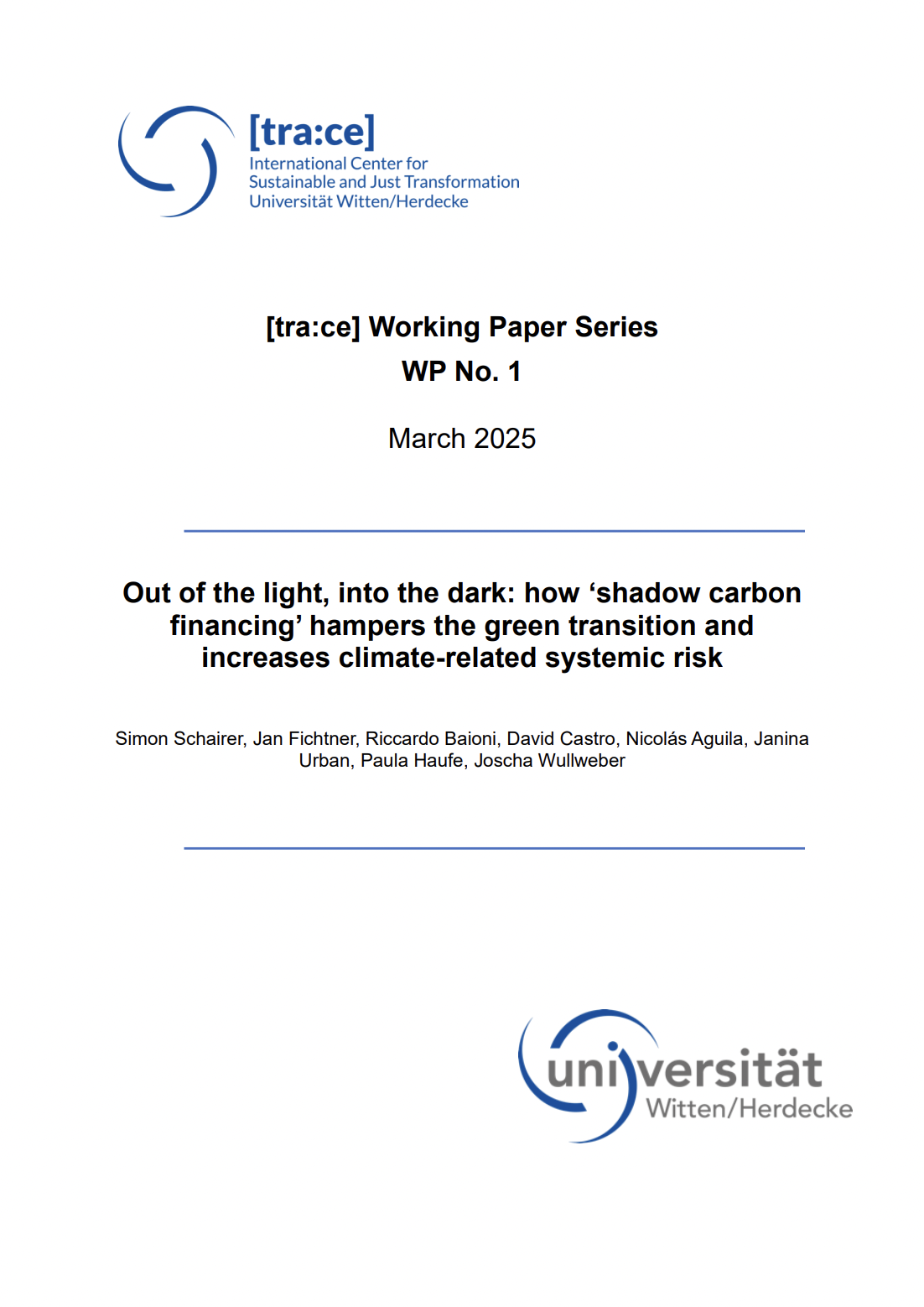
Out of the light, into the dark: how ‘shadow carbon financing’ hampers the green transition and increases climate-related systemic risk
Recent years saw major regulatory efforts to steer the financial system towards financing the transition to a net-zero carbon economy and phase out carbon financing. However, EU regulation focuses primarily on preventing greenwashing of retail funds and decarbonizing the banking system, while leaving the nexus of offshore finance and the shadow banking system untouched. These blind spots seriously undermine regulatory efficacy because offshore finance enables the obfuscation of financial flows, while shadow banking facilitates alternative financing to high carbon-emitting firms. Drawing on qualitative expert interviews and financial market data, the paper explains how the offshore-shadow-banking nexus hampers the green transition by introducing the concept of 'shadow carbon financing', which can operate through the following channels: (1) loan securitization, (2) emissions risk transfers, (3) bond financing, (4) carbon asset partitioning, (5) offshore corporate wealth chains, (6) private credit, and (7) proved developed producing reserves securitization. We demonstrate several instances of financial flows moving away from regulated and transparent forms of financing to less regulated and more opaque shadow carbon financing channels. Consequently, we argue that shadow carbon financing may also pose substantial systemic risk, as climate-related risks (e.g., stranded assets) increasingly accumulate in less regulated parts of the financial system.
- Veröffentlichungsdatum: 28.03.2025
- Autor:innen: Simon Schairer, Jan Fichtner, Riccardo Baioni, David Castro, Nicolás Aguila, Janina Urban, Paula Haufe, Joscha Wullweber
- Publikationsart: Working Paper
- Keywords: sustainable finance, offshore finance, shadow banking, green transition, climate-related risks, systemic risk
- Link zum PDF-Dokument
SuFi I Out of the light, into the dark: how ‘shadow carbon financing’ hampers the green transition and increases climate-related systemic risk
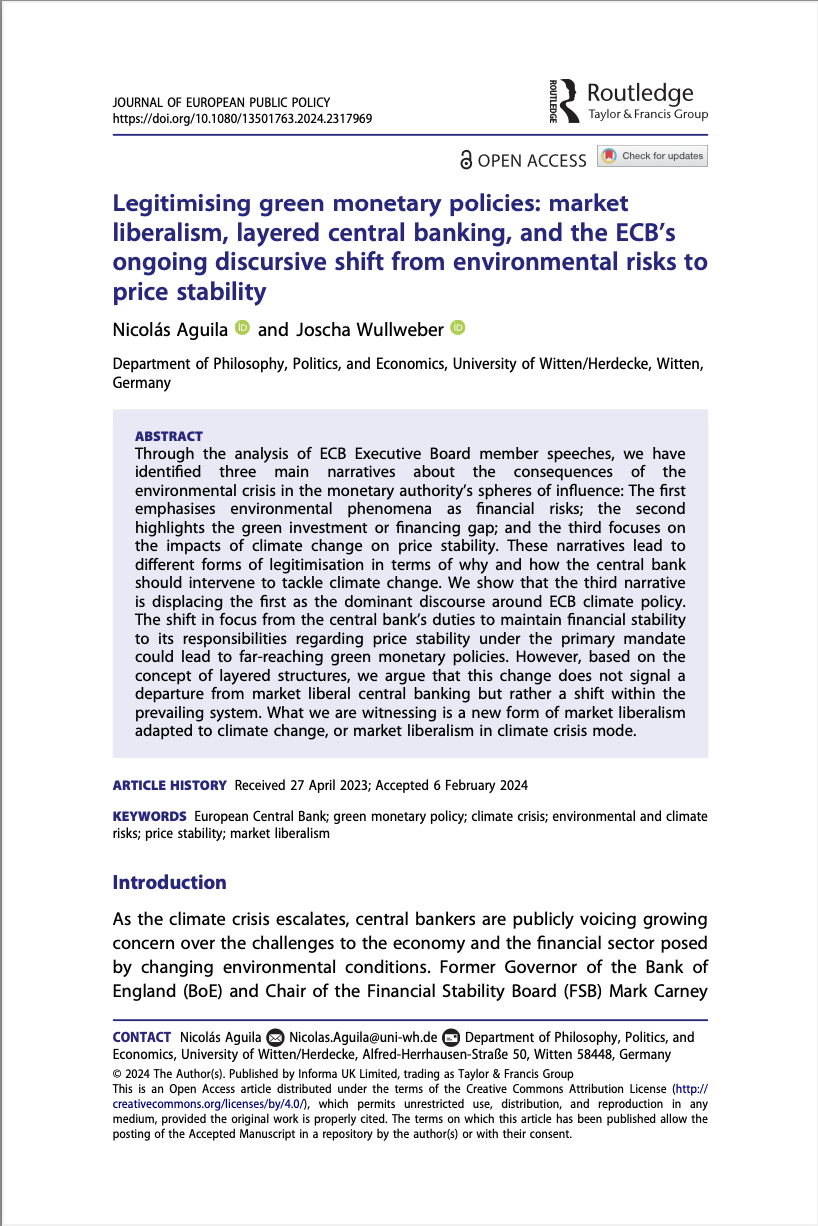
Playing the capital market? Sustainable finance and the discursive construction of the Capital Markets Union as a common good
The Capital Markets Union (CMU) project aims to create more integrated capital markets in Europe. However, the project faces resistance, and despite ongoing efforts EU capital markets remain fragmented. Based on an analysis of European Commission documents and ECB speeches, the paper identifies and conceptualises a set of discursive strategies employed to relegitimise the stalling CMU project and mobilise market-based finance for green investments. We distinguish two periods. First, the Commission used discursive strategies to introduce sustainable finance into the EU agenda, strategically framing it ‘as part of’ the CMU project. The strategies aimed to attract private finance, restore trust in market-based finance and reassure that the competitiveness of European industry would not be endangered by sustainability-related regulations. Second, since the launch of the European Green Deal and amid slow progress on the CMU, the Commission and ECB have constructed the CMU as key to financing the green transition and, more recently, other common goods. The analysis sheds light on the political dimension of this strategy by showing it primarily addresses the demands of certain fractions of the financial industry and, to a certain extent, of some environmental civil society organisations, while critical objections regarding market-based finance remain largely unacknowledged.
- Veröffentlichungsdatum: 17.02.2024
- Autor:innen: Nicolás Aguila & Joscha Wullweber
- Publikationsart: Article
- Keywords: European Central Bank; green monetary policy,
- Link zum PDF-Dokument
SuFi I Playing the capital market? Sustainable finance and the discursive construction of the Capital Markets Union as a common good
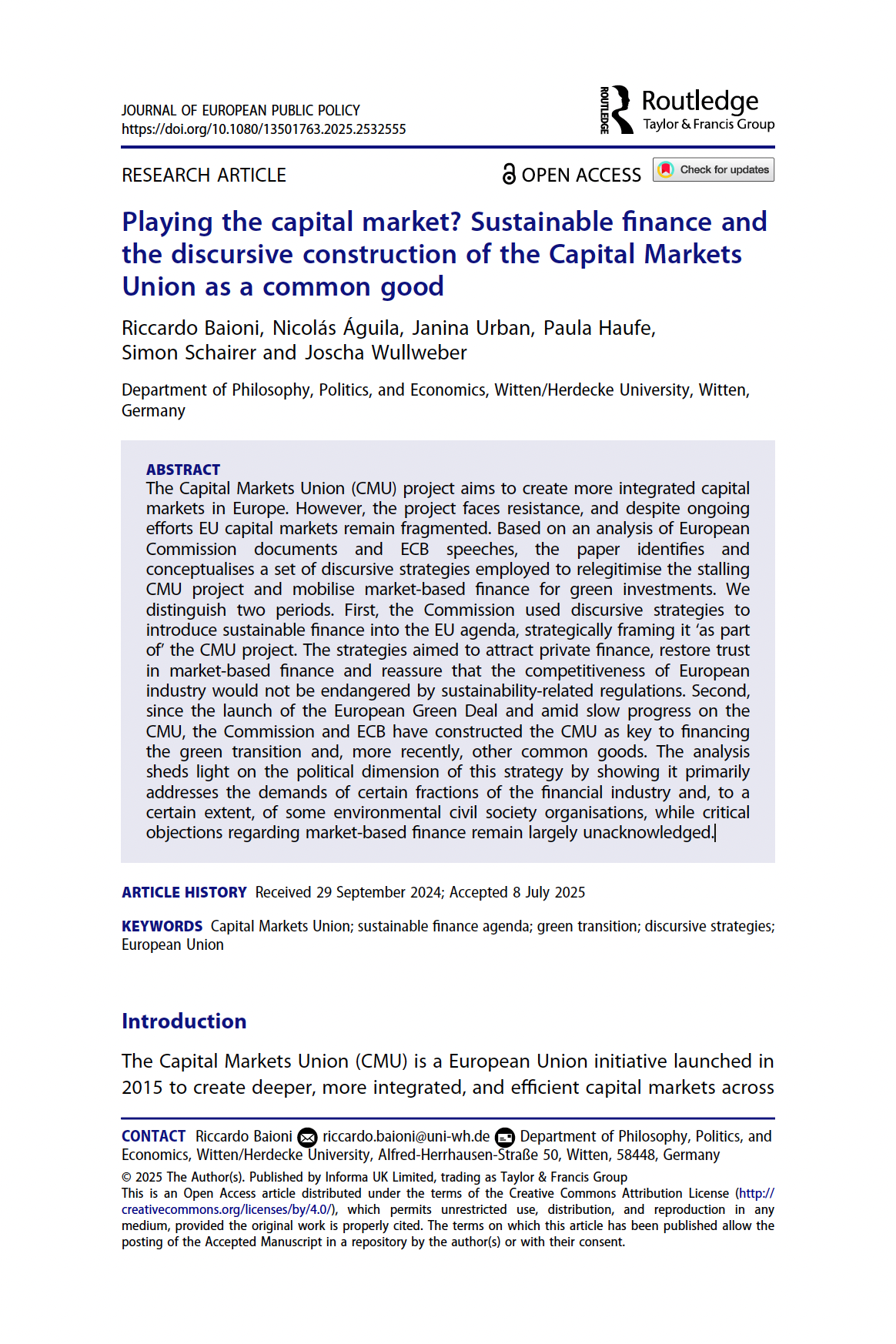
Playing the capital market? Sustainable finance and the discursive construction of the Capital Markets Union as a common good
The Capital Markets Union (CMU) project aims to create more integrated capital markets in Europe. However, the project faces resistance, and despite ongoing efforts EU capital markets remain fragmented. Based on an analysis of European Commission documents and ECB speeches, the paper identifies and conceptualises a set of discursive strategies employed to relegitimise the stalling CMU project and mobilise market-based finance for green investments. We distinguish two periods. First, the Commission used discursive strategies to introduce sustainable finance into the EU agenda, strategically framing it ‘as part of’ the CMU project. The strategies aimed to attract private finance, restore trust in market-based finance and reassure that the competitiveness of European industry would not be endangered by sustainability-related regulations. Second, since the launch of the European Green Deal and amid slow progress on the CMU, the Commission and ECB have constructed the CMU as key to financing the green transition and, more recently, other common goods. The analysis sheds light on the political dimension of this strategy by showing it primarily addresses the demands of certain fractions of the financial industry and, to a certain extent, of some environmental civil society organisations, while critical objections regarding market-based finance remain largely unacknowledged.
- Veröffentlichungsdatum: 08.07.2025
- Autor:innen: Riccardo Baioni, Nicolás Águila, Janina Urban, Paula Haufe, Simon Schairer and Joscha Wullweber
- Publikationsart: Article
- Keywords: Capital Markets Union; sustainable finance agenda; green transition; discursive strategies; European Union
- Link zum PDF-Dokument
SuFi I ‘Save the banks or save the planet?’: Governing through strategic ambiguity in EU sustainability-related banking regulation
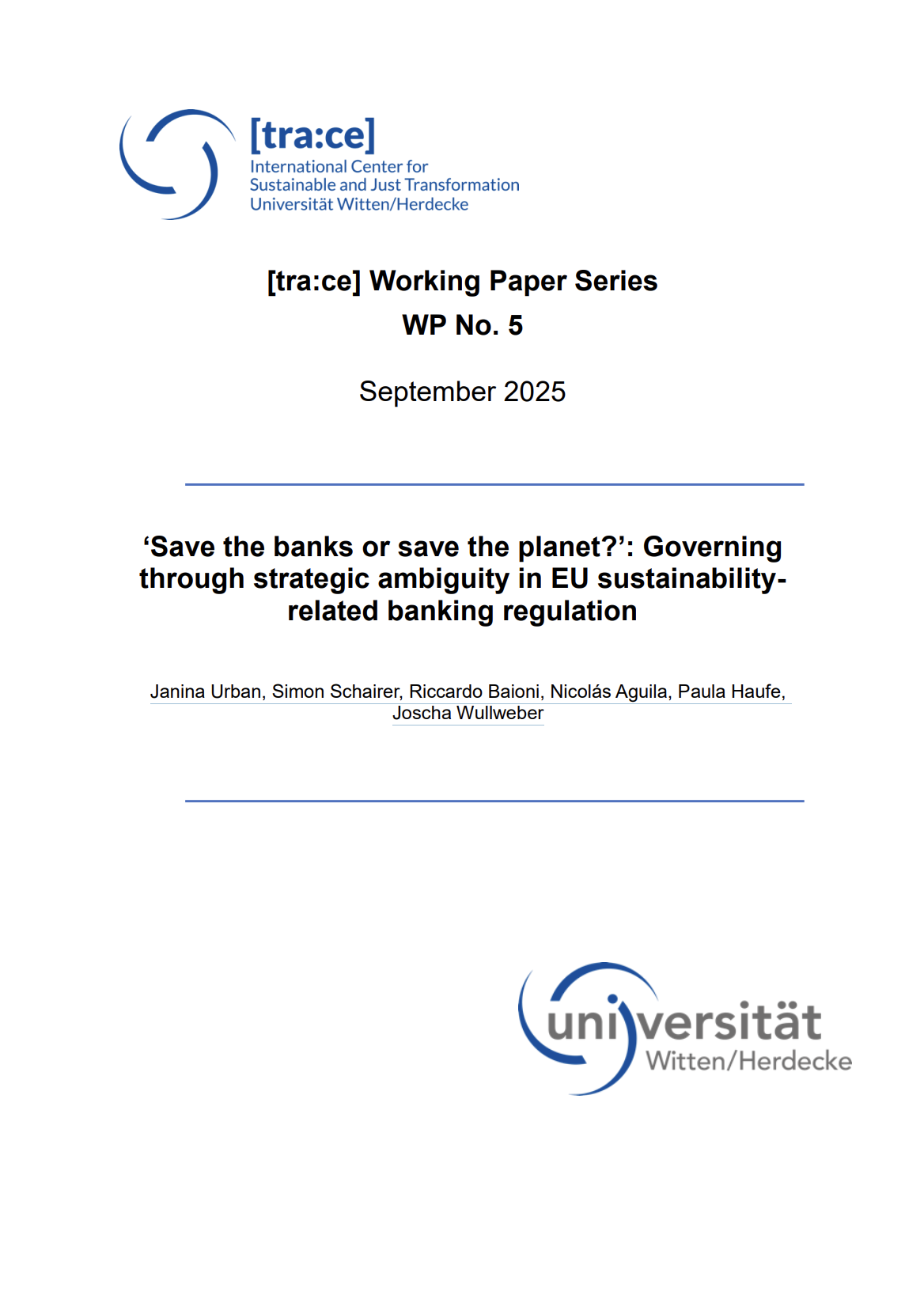
‘Save the banks or save the planet?’: Governing through strategic ambiguity in EU sustainability-related banking regulation
The literature remains divided on whether sustainability-related financial governance has shifted from a narrow risk-based approach to a stronger focus on transition pathways, and whether the currently dominant approach has the potential to redirect credit away from carbon-intensive investments towards green sectors. Building on a strategic-relational approach and the concept of strategic ambiguity, as well as insights from 30 expert interviews, documentary analysis, and three public consultations, we argue that the introduction of the current sustainability-related financial policy approach in the EU was conditioned on an ambiguously framed risk narrative. By reconstructing the policy process, we suggest that while strategic ambiguity initially helped to preserve an element of credit steering, it ultimately hampered its institutionalization. Thus, we conclude that the current policy approach neither constitutes a simple continuation of existing prudential approaches nor marks a substantial divergence from them, i.e., allocative policies. While we contend that the dominant approach has shifted towards a stronger focus on transition pathways, we suggest that it represents an unbalanced mediation of stakeholders' interests, which also limits its allocative potential.
- Veröffentlichungsdatum: 29.09.2025
- Autor:innen: Janina Urban, Simon Schairer, Riccardo Baioni, Nicolás Aguila, Paula Haufe, Joscha Wullweber
- Publikationsart: Working Paper
- Keywords: Banking regulation, Strategic ambiguity, Sustainable Finance, Climaterelated and environmental risk, Transition plans
- Link zum PDF-Dokument
SuFi I The ecor as global special purpose money: towards a green international monetary system to finance sustainable and just transformation
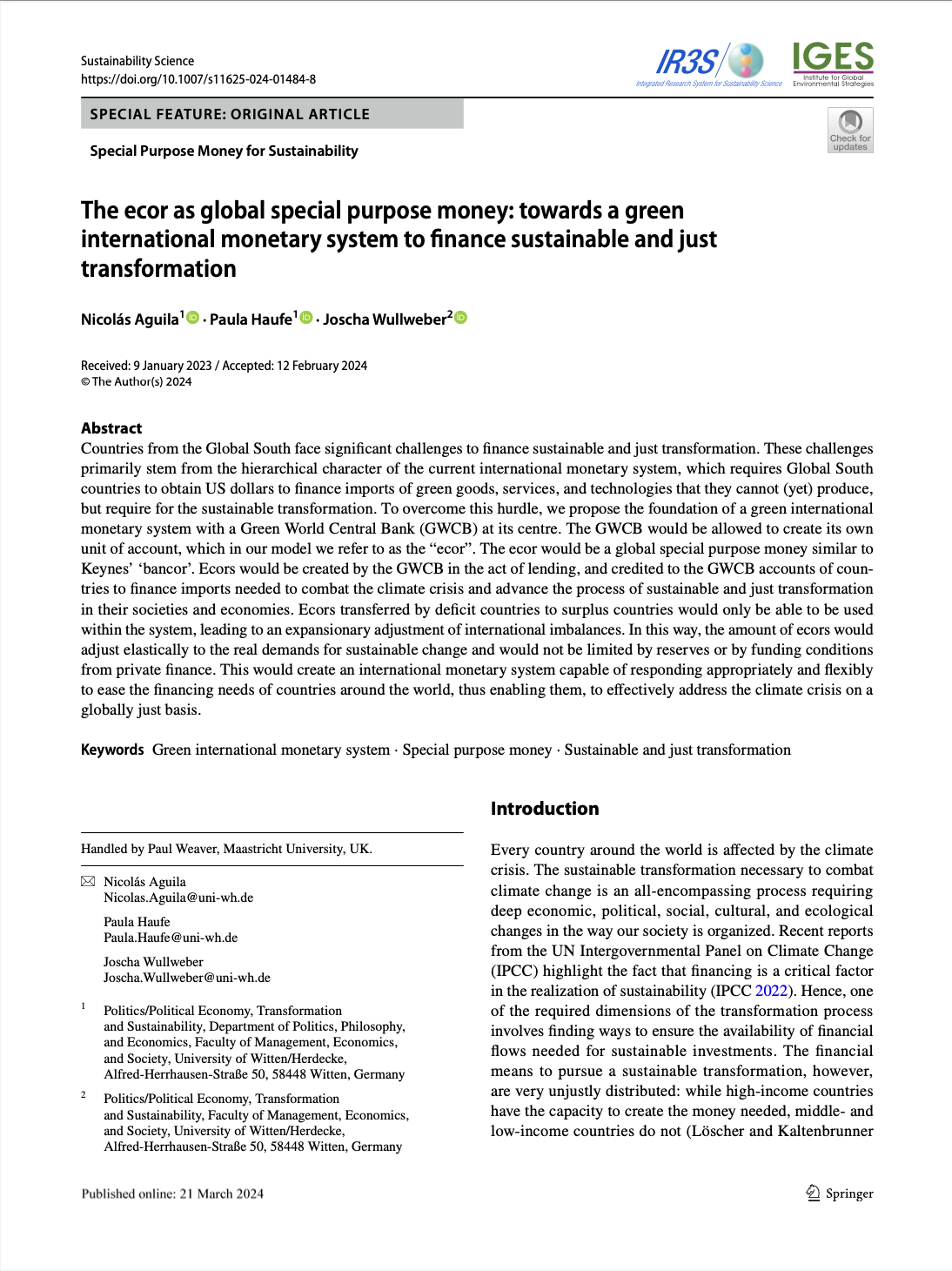
The ecor as global special purpose money: towards a green international monetary system to finance sustainable and just transformation
Countries from the Global South face signifcant challenges to fnance sustainable and just transformation. These challenges primarily stem from the hierarchical character of the current international monetary system, which requires Global South countries to obtain US dollars to fnance imports of green goods, services, and technologies that they cannot (yet) produce, but require for the sustainable transformation. To overcome this hurdle, we propose the foundation of a green international monetary system with a Green World Central Bank (GWCB) at its centre. The GWCB would be allowed to create its own unit of account, which in our model we refer to as the “ecor”. The ecor would be a global special purpose money similar to Keynes’ ‘bancor’. Ecors would be created by the GWCB in the act of lending, and credited to the GWCB accounts of countries to fnance imports needed to combat the climate crisis and advance the process of sustainable and just transformation in their societies and economies. Ecors transferred by defcit countries to surplus countries would only be able to be used within the system, leading to an expansionary adjustment of international imbalances. In this way, the amount of ecors would adjust elastically to the real demands for sustainable change and would not be limited by reserves or by funding conditions from private fnance. This would create an international monetary system capable of responding appropriately and fexibly to ease the fnancing needs of countries around the world, thus enabling them, to efectively address the climate crisis on a globally just basis.
- Veröffentlichungsdatum: 21.03.2024
- Autor:innen: Nicolás Aguila, Paula Haufe & Joscha Wullweber
- Publikationsart: Article
- Keywords: Green international monetary system I Special purpose money I Sustainable and just transformation
- Link zum PDF-Dokument
SuFi I The green banking gap: how bankability, business models, and regulations challenge banks’ decarbonisation

The green banking gap: how bankability, business models, and regulations challenge banks’ decarbonisation
Banks have been slow to increase green lending while they continue to finance high-GHG-emitting activities, a phenomenon we call the "green banking gap". Based on interviews with 21 bank employees, supported by interviews with 67 practitioners working for non-bank financial institutions, the public sector, and civil society organisations in areas related to sustainable finance, we argue that explanations for the green banking gap can be grouped into three broad categories: bankability, business model, and regulation. First, there are not many green firms and projects that meet banks' desired risk/return profile, while high-GHG-emitting activities remain bankable. Second, there are constraints to decarbonise banks' portfolios arising from the significant change in their business model in recent decades, making (green) corporate, and particularly project, lending relatively less important. Even when they lend, the characteristics of the lending process imply a bias towards high-GHG-emitting over green activities as balance sheets are locked in old loans and banks prioritise long-term relationships with their clients. Finally, there are constraints on green lending and incentives to high-GHG-emitting lending arising from financial (liquidity and capital requirements) and sustainability regulations and overall policy uncertainty over the future decarbonisation path of the economy.
- Veröffentlichungsdatum: 07.05.2025
- Autor:innen: Nicolás Aguila, Paula Haufe, Riccardo Baioni, Jan Fichtner, Janina Urban, Simon Schairer und Joscha Wullweber
- Publikationsart: Working Paper
- Keywords: banks, green financing gap, climate-related and environmental risks, bankability, sustainable finance
- Link zum PDF-Dokument
